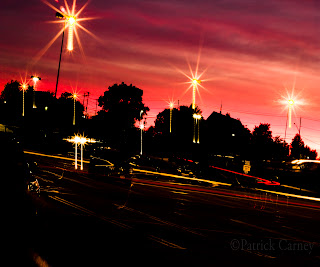Aperture is one of the holy trinity of taking photographs.
Combined with Shutter speed and ISO, aperture is how we expose our images. Aperture is referred to in f-stops. The aperture however has nothing to do with
your camera however (if it’s a DSLR) but on the lenses that you own. For
instance I own one very fast (large aperture lens) a 50mm f 1.8. This is the
lens I use primarily in the evening when I am trying to capture images where I
can’t use a tripod. Having such a large(fast) aperture allows me to use a relatively
high shutter speed even in less than ideal lighting without having to raise my
ISO. This allows me to capture nice, well exposed images without having the
grainy effect that takes place when using too high of an ISO.
This photo was taken with a 18-50 f2.8
lens. I shot it at f2.8 in the dusk
hours. As you can see my daughter is in
focus while the background is blurred together almost as if there was a
backdrop behind her and not a bunch of trees.
This effect is referred to as bokeh. It’s something I love to strive for
in portrait shots because it brings the subject into main view of the
audience. The person looking at the
photo is drawn to her face rather than getting lost looking at the nature that
is behind her.
In this photo I didn’t quite nail the depth of
field as well as I would have liked. I capture this street performer and
focused her rather well, however because of where the gentlemen next to her is
located he is still in focus as well which I’m not happy about. In this
instance I would have loved to have him blurred out much like the people in the
background are so that she would be the center of attention in the photo. For
this I would’ve needed some sort of tilt shift lens I believe, which allows you
to blur things in a different way than a normal lens.
Another feature of aperture is that it can
produce lovely lighting effects in a photo. While the lines in the parking lot
and the beams coming from the light are a result of a slow shutter speed, the
star light effect coming from all the lights comes from the sweet spot aperture
on my lens. I’ve found that on most of my lenses an aperture of f8-f12 will
produce the awesome effects I refer to as star bursts. I never see these effects when using a large
aperture nor when I have a tiny one. I believe it has to do with this range
being the optimal for lens sharpness. It captures everything terrifically.
Lastly for a landscape photograph one would want to have a
smaller aperture so that everything appears in focus, because in a landscape,
the scenery is the object, and everything needs to be relatively similar so
that all of the picture is admired.
This photo uses a small aperture to
achieve a rather large depth of field I generally only use large apertures at
night when I have a tripod with me. Because so much light is let in it can be
hard to have a steady hand with a slow shutter speed.




Hey, disregard my question about the f-stop range on your camera! I see you answered it here when discussing your lenses.
ReplyDeleteYour photos are really dynamic. I'm a little confused by the last paragraph though (probably why I can't get good night shots) - if you are using a large aperture why is the shutter speed not fast in relation to it?
I misspoke there. It should say I had a large aperture number. Such as F12-16 or something like that. In reality a large aperture is a low number: ie. f1.4 is a very large, fast aperture. I used a large f-stop number (so a low aperture: it's so confusing right?!)so I could have a large depth of field. Because I was getting a larger depth of field and the aperture was letting in less light I needed to slow down the shutter speed to get a properly exposed photo.
DeleteI like your pictures and you have a very informative post. The picture of the street performer came out great! I do understand where you're coming from though with having the background blurred. The gentleman walking next to her does distract from her slightly. Keep up the good work!
ReplyDelete